Related Tags
MC Systems Apollo Range Effects Review
Designed near Sydney, built in China, the new Apollo range of effects all come with a unique control feature.

Details
Prices: All £113
Contact:sales@mcsystemsmusic.com +852 2131 8319 www.mcsystemsmusic.com
Presented in a range of muted reds, blues, greens and browns, the eight pedals of the Apollo range from MC Systems look like they mean business; it’s hardware with an almost military spec feel to it. What makes them unique?
Designer Warren McAlister refers to them as Dynamic Response Pedals; they’re true bypass, but when you engage them the amount of effect depends on how hard you jump on the footswitch – and you can adjust the threshold to suit how heavy-footed you are. This adjustment occurs on the underside of the pedal and requires a small screwdriver.
The left hand footswitch, the V-Switch, turns the effect on and off. With the V-Switch on/off mini toggle engaged, the two knobs to the left of the unit become a matched pair of parameter controls, so what you get sonically depends on how hard you hit the V-switch. Which of your presets gets engaged is shown by an LED.
The right hand switch (labelled Alternate) allows you to switch between two other presets controlled by the two knobs on the right hand side of the unit… so you have access to four different settings from one pedal without having to bend down and fiddle with any knobs.
All very practical and straightforward.
NKM Dynamic Drive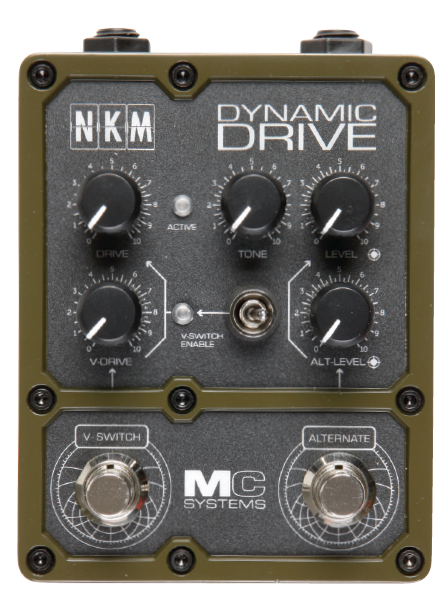 With the NKM the V-Switch controls the Drive setting, the Alternate changes the Level. As well as Drive and Level control knobs you get a Tone control that works across all settings. Setting the sensitivity of the V-Switch is easy, but the useable range seems quite tightly calibrated: the difference between a gentle press and slightly harder footfall and between an average touch and a seriously seismic stamp is a matter of millimetres around the centre point of the adjuster’s travel.
With the NKM the V-Switch controls the Drive setting, the Alternate changes the Level. As well as Drive and Level control knobs you get a Tone control that works across all settings. Setting the sensitivity of the V-Switch is easy, but the useable range seems quite tightly calibrated: the difference between a gentle press and slightly harder footfall and between an average touch and a seriously seismic stamp is a matter of millimetres around the centre point of the adjuster’s travel.
Once set to your liking, however, you can largely forget about this feature. The pedal is easy to get the hang of and the flexibility if offers is immediately apparent. Creating practical Drive and Level settings is easy, and switching between then is a breeze. The Tone control is nicely musical so you can tweak your basic sound very easily. The actual sound of the pedal is clean and open, and there’s very little background noise even at extreme settings.

LHR Dynamic Distortion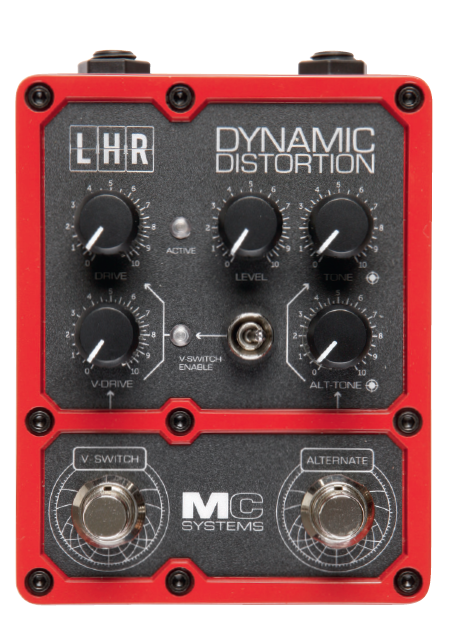 Here’s a pedal if you want to get seriously nasty. This time the V-Switch controls the Drive level while Alternate allows you to preset Tone, and there’s a master Level Control.
Here’s a pedal if you want to get seriously nasty. This time the V-Switch controls the Drive level while Alternate allows you to preset Tone, and there’s a master Level Control.
Given that different Drive levels will have a big effect on your output this pedal is arguably a bit more flexible than the NKM, as the ability to preset Drive and Tone lets you access very different sounds at the touch of a button.
At lower Drive settings the distortion can be made to sound swampy and shambolic with a ragged lo-fi breakup that’s great for contemporary Americana. Big rock chord voices can be found around the mid-drive territory and wailing solo tones emerge at higher settings. The master Level control means you can achieve any of these at a mixed and managed volume.
The tone control is quite amp-like, giving good bass and treble boost or cut, but you’ll need a separate graphic if you want to create more of a scooped mids sound.
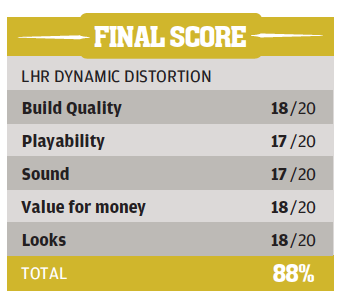 SYD String Reviver
SYD String Reviver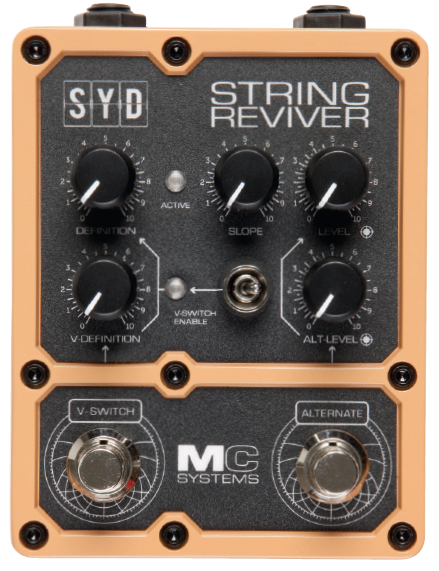 Of all the Apollo series pedals, this one wins the ‘niche’ award. According to the marketing materials, the pedal ‘brightens up your strings to bring out the sparkle in both electric and electro-acoustic instruments, giving definition in the mix, live and in the studio’.
Of all the Apollo series pedals, this one wins the ‘niche’ award. According to the marketing materials, the pedal ‘brightens up your strings to bring out the sparkle in both electric and electro-acoustic instruments, giving definition in the mix, live and in the studio’.
The implication is that this is a pedal designed to make old strings sound fresh again. You may well ask why anyone swould spend over £100 on a pedal to do this when a new set of strings costs about £6, but if you do a ton of gigs back-to-back, then you might just find yourself sounding a bit dead halfway though a set.
In practice the SYD is a sort of clean boost/preamp pedal with a fine-tuned tone control, called Slope, which works on the top end EQ shape. The V-Switch controls Definition, which is basically a drive control, but one that only pushes the sound in an obvious way at higher settings.
The Alternate footswitch again offers two level options. By balancing these parameters and brightening the top end it is possible to get more cut from a set of lifeless old strings; personally I found the SYD more useful as a four-stage clean booster with the capability to brighten the sound of a guitar with dark humbuckers. It’s pretty subtle, but pedals like this can often have a wide range of applications.
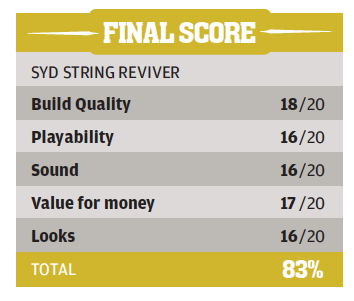 LAX Glass Chorus
LAX Glass Chorus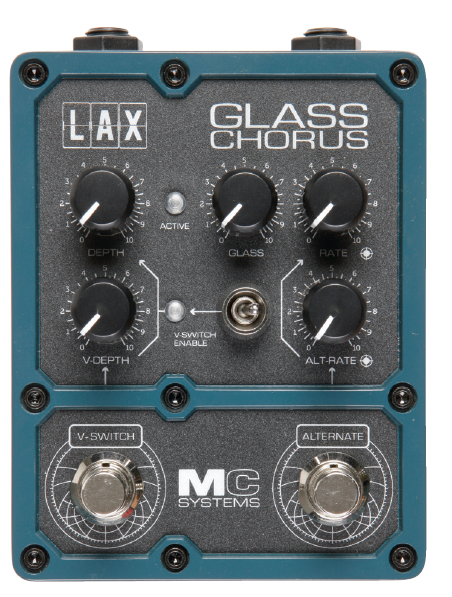 This analogue chorus pedal offers a similar four-stage architecture. The V-Switch lets you access two different Depth settings and the Alternate footswitch two different modulation Rate settings. This time the tone control is called Glass and, once again, it works as a hi-end EQ.
This analogue chorus pedal offers a similar four-stage architecture. The V-Switch lets you access two different Depth settings and the Alternate footswitch two different modulation Rate settings. This time the tone control is called Glass and, once again, it works as a hi-end EQ.
This is a lush-sounding chorus pedal that excels at creating some of the classic sounds we all know and love (think Come As You Are or Message In A Bottle). Where some chorus effects can get soupy or muddy at the extremes this one keeps its clarity, so you can explore some mad sounds if the fancy takes you.
The fact you can set up radically different but potentially related chorus patches and switch between them is very useful, and more subtle shifts of emphasis can be used to great effect when working on longer pieces of music where you might want to re-perform parts. The biggest limitation is that it only works as a mono effect. This will be fine for most guitarists in the live setting, but a stereo option for the studio would be good.
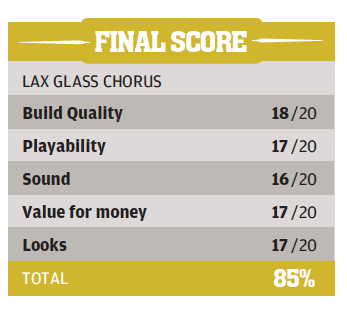 Verdict
Verdict
The Apollo pedals aren’t just another range of tick-all-the-boxes effects, and they do deserve our attention. All the units performed well and delivered excellent sounds. Having easy access to four preset sounds is extremely useful, especially live.
While the V-Switch system’s flexibility could be emulated in a pedal format with an on/off footswitch and a pair of A/B switches to access parameters, this design allows the units to occupy a standard-sized enclosure.
With added functionality but a familiar footprint on your pedalboard, these pedals are definitely practical tools for working musicians
